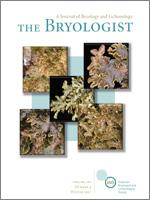A review of the crustose lichen genus Phlyctis in North America is presented derived from large-scale studies of chemical, morphological, and molecular data (ITS and mtSSU). Five species are recognized based on a combination of morphological and chemical characters, namely P. agelaea, P. argena, P. boliviensis, P. speirea and the newly described P. petraea. Analyses of molecular data supported the recognition of P. boliviensis and P. petraea but recovered P. agelaea, P. argena or P. speirea in a single clade with little internal phylogenetic structure, suggesting their circumscription based on reproductive mode and thallus morphology requires further study. An account is provided that includes an identification key, discussion of each species, distribution maps and illustrations of morphology. Phlyctis petraea, provisionally named more than a decade ago, is described as new to science. Molecular phylogenetic analyses using ITS and mtSSU sequence data both confirm the placement of P. petraea in Phlyctis and demonstrate two known chemotypes (one with norstictic acid and one with norstictic and stictic acids) are not reciprocally monophyletic and should be treated as variants of a single species. Psathyrophlyctis, described as a member of the Phlyctidaceae, is discussed and treated as a member of the Lecanorales incertae sedis.
How to translate text using browser tools
18 October 2017
A review of the lichen genus Phlyctis in North America (Phlyctidaceae) including the description of a new widespread saxicolous species from eastern North America
Zachary M. Muscavitch,
James C. Lendemer,
Richard C. Harris
ACCESS THE FULL ARTICLE

The Bryologist
Vol. 120 • No. 4
Winter 2017
Vol. 120 • No. 4
Winter 2017
Asexually reproducing crustose lichens
biogeography
chemotaxonomy
Phlyctella
Phlyctidia
secondary chemistry
septation




